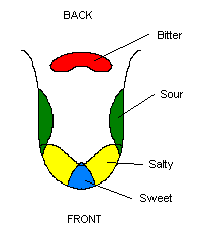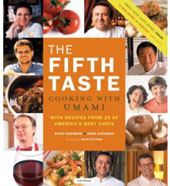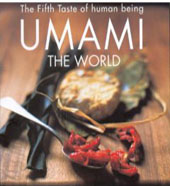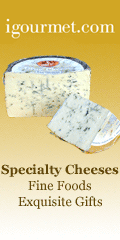

What does this classic Italian pasta dish with asparagus and Parma ham have to do with the Japanese concept of umami? Read all about it in this article, and enjoy the delicious umami recipe above for pasta with asparagus and Parma ham, recipe courtesy of the Umami Information Center.
|
KAREN HOCHMAN is Editorial Director of THE NIBBLE.
|
|
September 2006
Updated April 2009
|
 |
Sweet, Sour, Salty, Bitter And... Umami?
Page 6: Taste Buds “Tongue Map”
This is Page 6 of a six-page article. Click on the black links below to visit other pages.
Taste Buds “Tongue Map”
Here is the back-story on the tongue map, which identifies specific regions of the tongue as having the taste bud receptors for sweet, salty, bitter and sour. The original article was published in the Public Library of Science, a peer-reviewed journal. This information comes from “Cracking The Code” by Jane Bradbury, published in the March 2004 edition. You can read the complete article here.
- In 1901, the concept of the tongue map originated in research published by D.P. Hanig, a German scientist. He set out to measure the relative sensitivity on the tongue for the four known basic tastes. Based on the subjective responses of volunteers, he concluded that sensitivity to the four tastes varied, with sweet sensations peaking in the tip of the tongue, salty sensations behind the tip, sour at the sides, and bitter at the back. That was the extent of his paper.
 In 1942, Edwin Boring, a noted psychology historian at Harvard University, took Hanig’s raw data and calculated real numbers for the levels of sensitivity. The modern tongue-map was born (an example is shown at the right). While Boring’s numbers simply denoted relative sensitivities, they were plotted on a graph such that other scientists assumed areas of lower sensitivity indicated no sensitivity in those areas. Subsequent generations of school children were taught the science of the tongue map. In 1942, Edwin Boring, a noted psychology historian at Harvard University, took Hanig’s raw data and calculated real numbers for the levels of sensitivity. The modern tongue-map was born (an example is shown at the right). While Boring’s numbers simply denoted relative sensitivities, they were plotted on a graph such that other scientists assumed areas of lower sensitivity indicated no sensitivity in those areas. Subsequent generations of school children were taught the science of the tongue map. - In 1974, a scientist named Virginia Collings re-examined Hanig’s work. She agreed with his main point, that there were variations in sensitivity to the four basic tastes around the tongue. But she found that the variations were small and insignificant: that all tastes can be detected anywhere there are taste receptors. The receptors exist around the tongue, on the soft palate at back roof of the mouth and even in the epiglottis, the flap that blocks food from the windpipe.
- Subsequent research has revealed that taste bud seems to contain 50 to 100 receptors for each taste. While the tongue map is an “oversimplification” (if not downright inaccurate), textbooks continue to print it.
Learn More About Umami
 |
 |
|
The Fifth Taste: Cooking With
Umami, by Anna Kasabian and
David Kasabian. The book that introduced America to umami. Not only will you learn it all... you’ll be able to cook it all as well. Full of fun and creative recipes for all cooking levels, and
concepts of umami that will bring new perspectives to everything in your current repertoire. Click here for more information or to purchase. |
The Fifth Taste of Human
Being Umami the World, by
Yoko Takechi. A 72-page book about the history and usage of umami in both Eastern and Western cuisine, giving many varied examples of its sources in nature, as well as similarities and differences in its usage around the world. Click here for more information or to purchase. |
|

|





 In 1942, Edwin Boring, a noted psychology historian at Harvard University, took Hanig’s raw data and calculated real numbers for the levels of sensitivity. The modern tongue-map was born (an example is shown at the right). While Boring’s numbers simply denoted relative sensitivities, they were plotted on a graph such that other scientists assumed areas of lower sensitivity indicated no sensitivity in those areas. Subsequent generations of school children were taught the science of the tongue map.
In 1942, Edwin Boring, a noted psychology historian at Harvard University, took Hanig’s raw data and calculated real numbers for the levels of sensitivity. The modern tongue-map was born (an example is shown at the right). While Boring’s numbers simply denoted relative sensitivities, they were plotted on a graph such that other scientists assumed areas of lower sensitivity indicated no sensitivity in those areas. Subsequent generations of school children were taught the science of the tongue map. 


